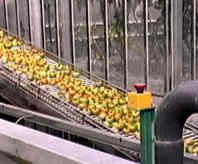

Flavor is the ultimate test of a good quality hydroponic tomato. However, there are other factors that determine overall quality: color, texture, firmness, shelf life, and nutrient levels are all important quality indicators. The single most important factor in all these issues (especially flavor) is the genetic makeup of the plant, so careful selection of the proper cultivar for the growing conditions is absolutely necessary.
 The
level of maturity at the time of harvest is the another important
factor affecting final fruit quality. For commercial trade,
tomatoes are harvested mature but unripe, often called the
"mature green" stage. U.S. standards for grades of
vegetables define a mature tomato as the one in which the
contents of two or more seed cavities have developed a jelly-like
consistency and the seeds are well developed.
The
level of maturity at the time of harvest is the another important
factor affecting final fruit quality. For commercial trade,
tomatoes are harvested mature but unripe, often called the
"mature green" stage. U.S. standards for grades of
vegetables define a mature tomato as the one in which the
contents of two or more seed cavities have developed a jelly-like
consistency and the seeds are well developed.
Mature fruit produce large quantities of ethylene, which will hasten ripening, increasing the carotenoids (red and yellow colors) and decreasing the chlorophyll (green color). Therefore, harvested fruit should be stored in well-ventilated areas, or in a low oxygen or high carbon dioxide atmosphere. The fruit should never be exposed to temperatures below 54° F (12.5° C) or chilling injury may result. In tomatoes, chilling injury can appear as pitting, shriveling, softening, uneven ripening, seed discoloration, or increased susceptibility to rot. Optimum ripening temperatures for tomatoes are 68-72° F (20-22° C), and an ethylene treatment of 100 ppm for 24 to 48 hours can be effective in producing evenly ripe fruit.
 The
major cause of postharvest losses in tomato is physical damage.
To prevent puncture wounds from stems, the calyx and stem should
be removed from the fruit immediately at harvest; although many
growers will leave the calyx on the fruit in order for the
consumer to recognize the fruit as greenhouse grown. Tomato
picking crews must be well trained in placing the harvested fruit
in the picking boxes. Many large greenhouse facilities have an
extensive system of canals to float the fruit from the growing
areas to the packing rooms, thereby minimizing physical damage to
the fruit. Another cause for postharvest loss is desiccation. In
tomato, about 65% of the water loss occurs through the stem scar.
Optimum relative humidity levels for harvested tomato fruit is
high, in the 90-95% range.
The
major cause of postharvest losses in tomato is physical damage.
To prevent puncture wounds from stems, the calyx and stem should
be removed from the fruit immediately at harvest; although many
growers will leave the calyx on the fruit in order for the
consumer to recognize the fruit as greenhouse grown. Tomato
picking crews must be well trained in placing the harvested fruit
in the picking boxes. Many large greenhouse facilities have an
extensive system of canals to float the fruit from the growing
areas to the packing rooms, thereby minimizing physical damage to
the fruit. Another cause for postharvest loss is desiccation. In
tomato, about 65% of the water loss occurs through the stem scar.
Optimum relative humidity levels for harvested tomato fruit is
high, in the 90-95% range.